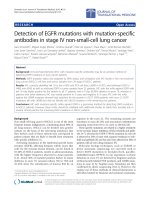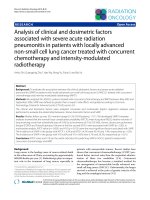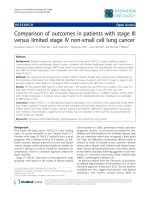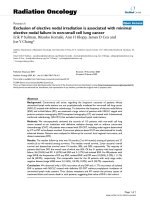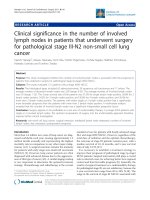Expression of Ciz1b in patients with non small cell lung cancer
Bạn đang xem bản rút gọn của tài liệu. Xem và tải ngay bản đầy đủ của tài liệu tại đây (327.71 KB, 7 trang )
Journal of military pharmaco-medicine n08-2018
EXPRESSION OF Ciz1b IN PATIENTS WITH
NON-SMALL CELL LUNG CANCER
Ho Van Son1,2; Ngo Tat Trung1,3; Nguyen Linh Toan1
SUMMARY
Introduction: Primary lung cancer is one of the most common malignant diseases. The expression
of Ciz1b appears to be limited to tumor cells, suggesting that this variant can be used as a
marker for the cancer. This study is to evaluate the expression and diagnostic role of Ciz1b in
lung cancer patients. Subjects and methods: 100 patients with non-small cell lung cancer and
51 healthy controls were recruited for this study. Relative expression of Ciz1b mRNA was
determined by realtime PCR. Results: Increased Ci1zb mRNA expression was observed
in patients with non-small cell lung cancer compared to healthy individuals (p = 0.008).
The expression of Ciz1b mRNA was negatively correlated with the ALT enzyme levels
(Spearman's r = -0.22, p = 0.045) and with the AST levels (Spearman' r = -0.2, p = 0.068).
The level of mRNA expression of the Ci1zb gene was significantly associated with tumor cell
differentiation in patients with non-small cell lung cancer. Ciz1b mRNA expression in serum was
capable of distinguishing lung cancer patients from healthy control (AUC = 0.602, p = 0.05).
Conclusion: The expression of Ciz1b is regulated by the occurrence of lung cancer and Ci1zb
plays an important role in lung cancer development, as well as has the potential as a biomarker
for diagnosis and prognosis of lung cancer.
* Keywords: Lung cancer; Non-small-cell lung carcinoma; Ciz1b; mRNA expression.
INTRODUCTION
Primary lung cancer is one of the most
common malignant diseases and also is
one of the leading causes of death from
cancers. Lung cancer accounts for about
12% of all types of cancers and 18% of
cancer-related deaths [1, 2]. Of these,
non-small-cell lung carcinoma (NSCLC)
accounts for more than 80% of lung
cancer. In Vietnam, lung cancer has
increased rapidly due to smoking, air
pollution, dust emissions and industrial
waste. According to the Ministry of Health,
there are about 20,000 to 30,000 new
cases of lung cancer annually and about
90% of primary lung cancer patients die in
the first five year [1].
Ciz1 (Cip1-interacting zinc finger protein)
enhances the activation of DNA replication
in mammals by interacting with cyclindependent E and A protein kinases.
It interacts directly with E and A cyclins,
CDK2, and p21 cyclin-dependent kinase
inhibitors. It also plays an important role in
DNA replication by regulating the expression
of genes, including cyclin D, which influence
cell proliferation [3]. Normally, Ciz1 is attached
to the salt- and nuclease-resistant protein
1. 175 Military Hospital
2. Vietnam Military Medical University
3. 108 Military Central Hospital
Corresponding author: Nguyen Linh Toan ()
Date received: 02/08/2018
Date accepted: 20/09/2018
130
Journal of military pharmaco-medicine n08-2018
component of the nucleus called a
"nuclear matrix". Ciz1 is in the spatial
structure of DNA replication. Some recent
studies described a Ciz1 variant “missing
the C-terminal region associated with the
nuclear matrix attachment and the
expression of this stable variant appears
to be limited to tumor cells, suggesting
that this variant can be used as a marker
for cancer”. Recent studies showed that
determining this variant of Cip1 can be
used for early diagnosis of lung cancer [3].
A previous study measured the
expression of Ciz1 using Western blot
and found that Ciz1 was present in the
lung tumor, but was absent in the nearby
tissues. The study also found that the
Ciz1 variant accurately identified patients
with stage I lung cancer [4]. The data
showed that the Ciz1 variant was an
important candidate for a specific marker
of cancer, which can detect early stage
lung cancer in the risky groups [5].
However, there are no reports of the
expression of this gene at diagnosis or
prognosis for NSCLC in Vietnam. This study
is to Evaluate the expression and diagnostic
role of Ciz1 in lung cancer patients.
SUBJECTS AND METHODS
1. Subjects.
The study was conducted in a crosssectional model, described in combination
with clinical examination and laboratory
analysis. 100 patients with NSCLC were
diagnosed by histopathology or cytology.
Patients were grouped according to the
stages of the disease according to TNM
classification criteria [6]. The control
group consisted of 51 healthy individuals
who had the corresponding age as those
with lung cancer. The group of healthy
people was examined for health and were
confirmed to be healthy and agreed to
participate in the study.
2. Methods.
* Preclinical and clinical examination:
All patients and the control group were
examined clinically and laboratory tests
such as hematology, biochemistry, imaging
(chest X-ray, chest CT) were performed.
The overall condition of the participants
was assessed using KPI (KPI: Karnofsky
Performance Index from 0 - 100 points) [7].
Patients were classified according to the
classification criteria [6]. The procedure
for sampling and storing samples was
conducted at 175 Military Hospital. 5 mL
of blood from each participant, both the
patients and healthy people was stored at
-20°C until use.
* Expression of Ciz1b mRNA:
The expression level of Ciz1b in the
serum of patients with lung cancer and
control group was determined by realtime
PCR. Total RNA was extracted from
plasma samples of patients and healthy
individuals using an RNA extraction kit
following the manufacturer's instructions.
cDNA don’t need this were synthesized
from RNA using the Thermo Scientific
cDNA kit. You have already said this at
the beginning of the paragraph. Each
realtime PCR reactions include Master
Mix SYBR Maxima 2X, Primers 5 pm
(Ciz1b and ABL), Water and cDNA template.
The total volume of each reaction is 12 μL.
131
Journal of military pharmaco-medicine n08-2018
The thermal cycle for the realtime PCR
reaction for ABL and Ciz1b was 50°C for
2 mins, 95°C for 10 mins, 95°C for 15s,
and repeat for 45 cycles.
* Statistical analysis:
Data were analyzer using SPSS V.19.
The diference between groups was analyzed
using Mann-Whitnay U test for nonparameter variables. Sperman correlation
coefficient (RS) was used to investigate the
relationship between continuous variables.
p < 0.05 was considered statistical
significance.
RESULTS
1. Baseline characteristics of the
study subjects
Lung cancer patients had an average
age of 60 years, while the control group
had an average age of 53.88 years.
No significant difference in age between
patients with lung cancer and the healthy
controls was observed (p = 0.158).
In terms of gender distribution among the
patients, 73 males and 27 females. There
were 35 men, and 16 women in the
control group. No significant difference in
gender distribution between the two groups
was found (p = 0.225).
2. Clinical characteristics
cancer patients.
of
lung
On admission, the common clinical
symptoms were coughing, chest pain,
difficulty breathing and weight loss.
49 patients (49%) had coughing, 43 patients
(43%) had chest pain, 12 patients (12%)
had shortness of breath, 7 patients (7%)
had weight loss and 24 patients (24%)
132
had other clinical symptoms. Of the
100 patients with lung cancer, 34 had
tumors in the upper lobes of the right
lung, 26 had lobular tumors in the left
lung, 18 had lobular tumors in the right
lung, 13 had tumors in the lower lobes of
the left lung and 9 patients with tumors in
the right lobe of the lung.
According to the TNM classification
system [6], patients were classified into
stages IA, IIA, IIIA, IIIB and IV. The majority
of patients were in stage IV (76%), 15% in
stage IIIB, 5% of patients was in stage IIA,
and only 2% of patients were in stages
IA and IIIA. In terms of tumor cell
differentiation, 56% of patients had
grade 2, 35% of patients had grade 3,
and 9% of patients had grade 1. These
results indicated that the majority of patients
were at the late stages.
General ultrasound was performed
for 82 patients and we found 38 patients
(46%) had abnormal images. Bone
morphogenesis was performed for 63
patients, 34 of whom accounted for 54%
of abnormal images. Radiography revealed
that 49/51 patients (96.1%) had abnormal
images. CT images showed 82/93 patients
(88%) with tumors, 18/93 patients (19%)
with pleural effusion, and 8/93 patients
(8.6%) with thickened lung membranes.
PET-CT was performed for 26 patients
and 100% of patients had abnormal
images, of which 16/26 patients (61.5%)
had tumors, 7/26 patients (26.92%) had
pulmonary effusion, 13/26 patients (50%)
had malignant lesions, and 17/26 patients
(65.4%) had lymph nodes.
Journal of military pharmaco-medicine n08-2018
3. Expression of Ciz1b in patients with lung cancer and healthy individuals.
Figure 1: Expression levels of Cizb1 mRNA in patients and controls.
The relative expression of the Ciz1b gene in the plasma of patients with lung and
healthy cancers is calculated by the ΔCt method with the expression of ALB gene as
the reference. The analysis showed that the expression of the Ciz1b gene in patients
with lung cancer (10.02 ± 4.83) was significantly higher than that in the controls
(7.75 ± 2.63) (p = 0.008).
4. Correlation between Ciz1b expression and clinical parameters.
Table 1: Association between Ciz1b expression and differentiation of tumor.
Gene
Ciz1b relative
expression
Differentiation
Lung cancer
(n = 63)
Grade 1 (n = 6)
Grade 2 (n = 35)
Grade 3 (n = 22)
10.02 ± 4.83
6.55 ± 2.49
9.98 ± 4.34
11.5 ± 1.19
p
< 0.05
Tumor differentiation reflects the degree of malignancy of cancer cells. To assess
the association of Ciz1b expression with tumor development, we compared the expression
level of Ciz1b with degrees of differentiation including grade 1, grade 2, and grade 3.
The results showed that Ciz1b mRNA expression was the lowest in the group with
grade 1, increased in the group with grade 2 and the highest in the group with grade 3
(p < 0.05). These results suggested that the expression levels of Ciz1b increased with
the degree of differentiation of the tumor and was closely related to the development
and differentiation of lung cancer cells.
133
Journal of military pharmaco-medicine n08-2018
Figure 2: Correlation between Ciz1b mRNA expression and liver enzyme levels.
We also analyzed the association of Ciz1b expression with other clinical
parameters. Results showed that Ciz1b mRNA expression was negatively correlated
with ALT enzyme levels (Spearman's r = -0.22, p = 0.045) and with the AST levels
(Spearman' r = -0.2, p = 0.068). However, there was no association between Ciz1b
mRNA levels with analyzed clinical parameters (p > 0.05). In addition, Ciz1b mRNA
expression was not correlated with the level of hemoglobin, hematocrit, red blood cells,
lymphocytes, platelet counts and monocytes (p > 0.05). Ciz1b mRNA expression was
also not correlated with the ion index tests such as Na+, K+ and Cl- concentrations,
kidney function tests such as urea and creatinine, and with cancer markers such as
CEA and CyFra 21.1 (p > 0.05).
5. Potential diagnostic function of Ciz1b expression for lung cancer.
Figure 3: Diagnostic potential of Ciz1b mRNA expression in lung cancer.
134
Journal of military pharmaco-medicine n08-2018
Ciz1b mRNA expression was significantly
different between lung cancer patients
and controls, and was associated with the
differentiation of lung cancer tumor.
Therefore, Ciz1b mRNA expression may
have a potential for screening and
prognosis of lung cancer. We analyzed
the effectiveness of Ciz1b expression for
identification of lung cancer from the
control group. The results showed that
Ciz1b mRNA expression in serum was
capable of distinguishing lung cancer
patients from healthy control. However,
the diagnostic efficacy was not high, and
the AUC was only 0.602 (p = 0.05).
DISCUSSION
Primary lung cancer is one of the most
common malignant diseases and also is
one of the leading causes of death from
cancers. Ciz1 plays an important role in
triggering DNA replication by regulating
the function of cyclin E and A-dependent
protein kinases. Ciz1 also interacts
directly with cyclins E, cyclins A, CDK2
(cyclin-dependent kinase 2) and with the
cyclin-dependent p21 kinase inhibitor to
regulate DNA replication and the expression
of genes involved in the cell cycle
including cyclin D [8]. However, only a few
studies have addressed the role of the
Ciz1b gene in lung cancer.
The level of Ciz1 expression has been
shown in early cell differentiation. Some
variants of Ciz1 that are involved in
cancer development are deficient in exon
4 and the expression of different Ciz1
variants is closely related to the expression
of the cyclin A1 protein. This is a vital protein
in the development and differentiation of
cells [9]. A previous study showed that the
Ciz1b had the potential as a biomarker
that was usually found in patients with
lung cancer but not in healthy individuals
[3]. In that study, the authors used the
Western blot method for protein detection,
which was quite complex and was not
optimized to be a method used for
diagnostic purposes. Therefore, theELISA
method of quantifying serum protein
levels has been established [3]. In our
study, specific primers were designed to
amplify and quantify the expression of
Ciz1b mRNA in the serum by realtime
PCR, which provides a rapid and accurate
result regarding the expression of Ciz1b
mRNA in the serum.
Another recent study has shown that
Ciz1b was sensitive enough to identify
patients with stage I cancer in high-risk
groups, including patients with benign
pulmonary lung disease, pneumonia,
asthma, chronic obstructive pulmonary
disease (COPD) and smokers [3]. This
study indicated that cancer patients had
significantly higher levels of Ciz1b compared
to those in controls and the Ciz1b levels
also increase with age in patients with
NSCLC. The study also found that Ciz1b
levels in patients with stage I lung cancer
were significantly higher compared to
smokers, and Ciz1b levels were the highest
in patients with basal cell carcinoma
followed by adenocarcinoma, pneumothorax
and patients with benign neoplasia. In our
study, the level of mRNA expression of
the Ciz1b gene in the serum of patients
with NSCLC was significantly higher
than that of controls. This result confirms
Ciz1b gene expression is affected by the
135
Journal of military pharmaco-medicine n08-2018
disease status, suggesting that Ciz1b plays
an important role in the development of
lung cancer. The results also suggest that
Ciz1b gene may be used as a biomarker
for diagnosis and prognosis of lung
cancer [5].
The study showed that Ciz1b levels
help diagnose cancer patients with an
accuracy threshold of 98% for patients
with NSCLC and controls (AUC = 0.96).
When comparing patients with NSCLC in
stage I with asymptomatic smokers, or those
with benign pulmonary lymph nodes, the
AUC reached 0.913, and 0.905, respectively.
In this study, we also analyzed the
diagnostic potential of Ciz1b for patients
with NSCLC and the results showed that
Ciz1b was capable of detecting patients
with NSCLC (AUC=0.602). Therefore,
determining the presence of Ciz1b in the
serum of high-risk groups is an effective
non-invasive method for diagnosing,
screening and predicting lung cancer.
CONCLUSION
Increased Ci1zb mRNA expression in
patients with NSCLC was observed
compared to healthy individuals. Ci1zb
mRNA expression levels were associated
with tumor cell differentiation and
correlated with liver enzyme levels. Ci1zb
plays an important role in lung cancer
development and has the potential as a
biomarker for diagnosis and prognosis of
lung cancer.
136
REFERENCES
1. Nguyễn Hải Anh, H.H.T. Tình hình ung
thư phổi tại Khoa Hô hấp, Bệnh viện Bạch
Mai trong 10 năm từ 1991 - 2000. Tạp chí
Y học Thực hành. 2005, 513, tr.3.
2. Dubey S, C.A. Powell. Update in lung
cancer 2006. Am J Respir Crit Care Med.
2007. 175 (9), pp. 868-874.
3. Higgins G et al. Variant Ciz1 is a
circulating biomarker for early-stage lung
cancer. Proc Natl Acad Sci. USA 2012, 109
(45), pp. E3128-3135.
4. Rahman F.A, N. Aziz, D. Coverley,
differential detection of alternatively spliced
variants of Ciz1 in normal and cancer cells
using a custom exon-junction microarray.
BMC Cancer. 2010, 10, p.482.
5. Coverley D et al. A quantitative
immunoassay for lung cancer biomarker
Ciz1b in patient plasma. Clin Biochem. 2017.
50 (6), pp.336-343.
6. Sobin LH, G. Wittekind CH. TNM
classification of malignant tumors. 7 ed. New
York: Wiley-Liss. 2009.
7. Buccheri G, D. Ferrigno, M. Tamburini.
Karnofsky and ECOG performance status
scoring in lung cancer: A prospective,
longitudinal study of 536 patients from a
single institution. Eur J Cancer. 1996, 32A (7),
pp.1135-1141.
8. Coverley D, J. Marr, J. Ainscough Ciz1
promotes mammalian DNA replication. J Cell
Sci. 2005, 118 (Pt 1), pp.101-112.
9. Greaves E.A et al. Cancer-associated
variant expression and interaction of CIZ1 with
cyclin A1 in differentiating male germ cells.
J Cell Sci. 2012, 125 (Pt 10), pp. 2466-2477.
